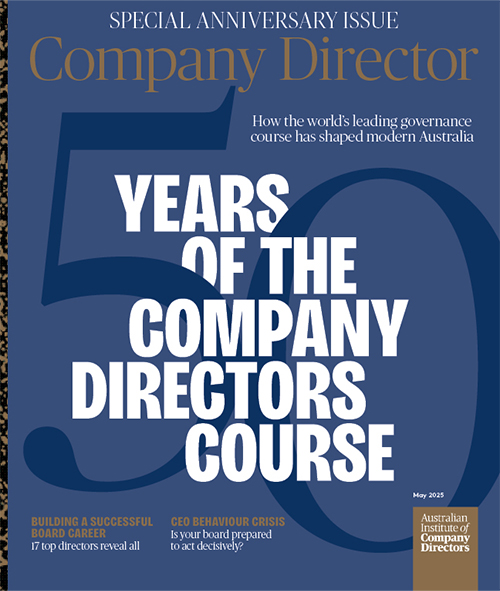Compliance, communication and reporting can be simplified with the use of a board portal.
The days of printing board documents and having them couriered to directors are long gone, thanks to the great strides made in the board portal space.
Raph Goldsworthy, managing director of Better Boards, says the biggest improvements to portals over the past five years have been the adoption of artificial intelligence (AI) and better security practices.
Although some still use manual processes, Goldsworthy says boards have generally become more tech-savvy. “Portals have also become easier to use, making them more accessible,” he adds.
They’ve improved from a cost perspective, too. “Boards once had to pay quite a lot to access more sophisticated features, but today some of our clients are not-for-profits or companies operating on a shoestring budget,” says Goldsworthy, adding that the NFP take-up is growing exponentially.
“I think we’re also going to see more small boards starting to leverage the technology,” he says. “It helps them grow that compliance piece without having to add more staff or other resources.”
The market is also becoming more competitive. “Every time I turn around, there’s another player. Boards now have more choice,” says Goldsworthy. “There’s a bit of variation among portals. They all deliver a core offering oriented towards boards, but each has a different philosophy on how it delivers it and the features it includes.”
A recent OnBoard survey found that 13 per cent of the 1400 respondents still rely on paper, printing out board books to be passed around at the start of a meeting or shipped to a home address. The majority of respondents — some 62 per cent — said they still rely on email and PDFs as their main preparation and distribution method.
“That’s a step above paper in terms of security, but insert the wrong email address and information can easily end up going somewhere it shouldn’t,” says Gavin Guest, vice-president of product management at OnBoard.
Beyond that, 25 per cent of respondents, including those with a dedicated board portal, said they were using a digital solution (such as SharePoint or Google Drive) but not a purpose-built one, like OnBoard or another board portal.
From a compliance point of view, if interested parties — be they directors or auditors — need to know about the discussions that took place, the decisions made and who is accountable, AI can quickly and cost-effectively search and summarise information from the board portal.
“It can provide a place for those in charge of compliance to make sure people are doing things in a way that is compliant,” says Guest.
“It’s easy for directors to find what they need,” he adds. “Directors are busy. When it comes time to prepare for a board meeting, they don’t need to be searching for things. Everything is organised right where they want it — it’s on one screen.”
Using AI in a secure and confidential manner is highly recommended. Never use public access versions of AI to summarise or otherwise upload sensitive board materials, says Guest. Once it’s uploaded into a public model, the AI could retain and distribute the information to other parties.
Indispensable for modern governance
BoardPro director Nigel Scott believes COVID-19 and an increase in remote meetings have led to the big uptake in board portals. “They’ve also evolved beyond simple document management tools into comprehensive governance platforms,” he says.
“They are now so much more than just digital repositories. They enhance governance by providing security, collaboration tools, real-time updates and performance monitoring. As board responsibilities grow in complexity, these benefits make them indispensable for modern governance.”
Steven Bowman FAICD, managing director at Conscious Governance, notes portals do more than offer a compliance checklist. “They’re a tool for transforming how boards think and act.”
Bowman says portals help directors keep up with regulatory changes by providing secure document sharing, push notifications and AI-driven summaries. “Advanced portals also offer gap analysis tools that highlight areas where compliance obligations are unmet and suggest corrective actions,” he adds.
Board portals measure and track compliance performance through dashboards, analytics and reporting tools. “These features provide real-time insights into adherence, including board meeting attendance, timely submission of disclosures and risk-mitigation actions,” observes Bowman.
“Many integrate KPIs and benchmarking tools to help directors assess compliance effectiveness over time. The next level for board portals would be to measure compliance performance integrated with strategic vision and goals. Compliance with an oversight of strategy and vision is where true innovation can begin.”
AI at work
Scott says portals use AI tools — such as predictive analytics, automated summaries and intelligent task tracking — that enable them to automate repetitive jobs, improve decision-making and enhance compliance monitoring.
He says boards can expect further AI-driven enhancements, as well as personalisation and integration with broader governance, compliance and risk systems. This will improve decision-making, collaboration and risk management, and will also create tailored experiences to make governance more effective and efficient.
Goldsworthy says AI will likely be a feature of all board portals in the future. On the flip side, he says that even with the latest AI models, there are challenges, particularly in terms of fabricated data (which is improving) and generic summaries of board papers.
“This often stems from insufficient context provided to the AI, making it difficult to generate meaningful insights,” he says. “AI lacks the nuance and depth that a board collectively brings to discussions, especially around complex and organisationally specific issues like risk.”
Bowman notes that the industry is considering a range of AI functions (see breakout). He says portals are also adding tools such as best practice examples and knowledge libraries.
But he also offers a word of caution. “Technology alone doesn't create strategic awareness or improve governance. The real power lies in how boards leverage these tools to enhance their decision-making and create value for their stakeholders.”
Looking ahead, Goldsworthy says machine learning and AI are likely to be used for advanced applications, such as board-wide personalisation and scenario planning. This could help them to better anticipate challenges, refine their strategic direction and navigate complexity more effectively.
“Augmented reality (AR), when combined with AI, may also play a role by blending digital insights with real-world decision-making in ways that virtual reality (VR) cannot,” he says.
“Unlike VR, which creates a fully immersive digital environment, AR enhances the physical world by overlaying it with relevant data, insights and interactive elements.”
He says for boards, this could mean real-time access to governance data and compliance updates, or displaying performance insights alongside physical documents or in a boardroom setting — for example, when brainstorming on a whiteboard or similar. AI-powered AR could highlight trends, flag risks or suggest action points as directors review reports, making complex information easier to interpret and act on. This integration would allow them to remain engaged in discussions while benefiting from AI-driven enhancements without the need for a fully immersive, isolating experience.
“By keeping interactions within the real-world environment, AR ensures that AI-driven insights remain accessible and practical, and are seamlessly integrated into the board’s workflow, helping to improve decision-making, scenario planning and overall governance efficiency.”
AI functions heading your way
Steven Bowman notes AI is boosting board efficiency by automating administrative tasks, providing predictive insights and enhancing decision-making.
He says key AI-driven features available within board portals — either now or soon to come — include:
Intelligent agenda management: AI recommends meeting agendas based on past discussions and upcoming compliance deadlines.
Automated document summaries: AI scans lengthy reports and provides executive summaries for quick reference.
Sentiment analysis: AI analyses meeting discussions to highlight emerging concerns or board sentiment trends.
AI-powered search: Directors can instantly retrieve governance documents using natural language queries.
Automated minutes: AI captures key points and decisions in real-time, generating detailed minutes and tracking action items automatically. Using tools such as Otter, Jamie or Fireflies offers big productivity gains in functions.
Personalised briefings: AI creates tailored summaries and insights for individual directors, enhancing meeting preparedness.
Risk forecasting by machine learning: Using predictive analytics to assess governance and compliance risks.
Analysis: Can be used for board evaluations, monitoring progress against key recommendations from reviews approved by the board.
The AICD is proud to partner with leading board performance platform BoardOutlook to deliver AICD Board Insights.
This article first appeared under the headline ‘Another dimension’ in the April 2025 issue of Company Director magazine.
Latest news
Already a member?
Login to view this content



